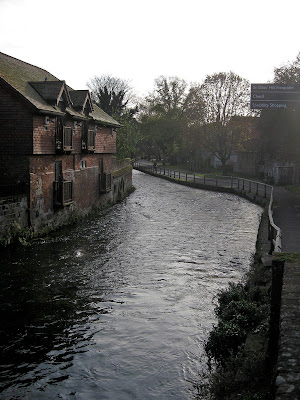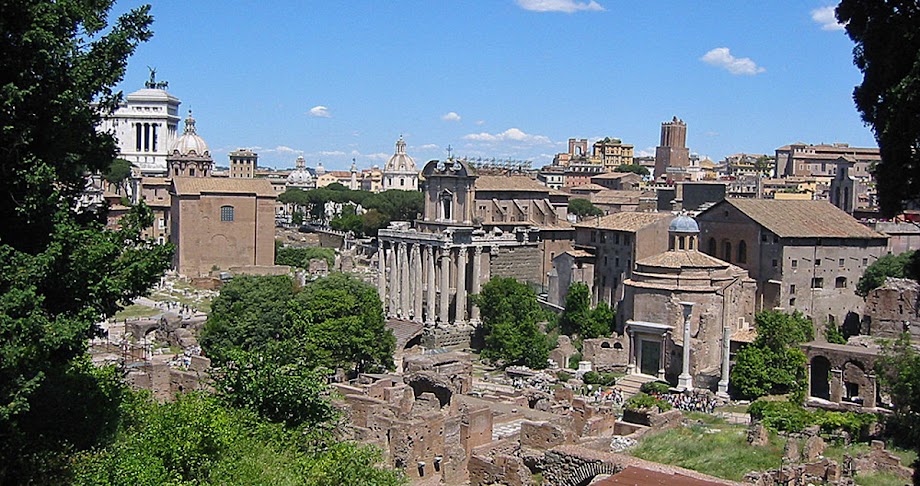My first work of art is a pop tune (and I'll need my Rudy Vallee megaphone to do it justice):
"Winchester Cathedral,
you're bringin' me do-own
you stood there and watched as
my baby left town..."
No, that is not the reason I decided to visit a country town an hour's train ride west southwest of London, although I'll admit that the reason is slightly more complicated than it might seem. For indeed my prime reason to tour the country town of Winchester WAS its cathedral. Not that I'd ever been brought down by it. In my sordid past it took much less than an imposing medieval structure to bring me down, certainly as far as women are concerned! A stupid phrase, a seemingly innocent discovery, a slight misunderstanding were enough to start any relationship of mine tumbling. Which is why I retired from that field of battle many years ago.
But the cathedral at Winchester,
 |
| Winchester Cathedral |
But first some history. Winchester was a very important city in the old days...and I mean very old days. Like York, Colchester and London, Winchester, then named Venta Belgaum, was an important city in the days of the ancient Roman empire, and similar to the others it entered a period of decline when the Romans left. But beginning in the late seventh century Winchester became the capital city of the area of England known as Wessex.
 |
| Alfred the Great in Winchester |
After a time London, with its powerful position on the mighty River Thames, displaced Winchester as capital, and Winchester nestled down into a quiet country town whose mostly well-healed residents seem to enjoy, from my brief peek at the place, quite the idyllic existence.
Back to the cathedral, in fact to the interior of the cathedral, which like the old rock song and much older adage about a book and its cover, struck me as quite stunning. Before I let you enter, however, have a look above at the photo of the exterior. While it is for the most part well done -
 |
| West front of the cathedral |
The interior, however, boasts the longest nave of any cathedral in Europe.
 |
| The nave of the cathedral |
And it shows! In fact it soars! Not literally so tall as those in some gothic cathedrals, the nave of Winchester seems gigantic, because of its length, because of the beauty of its ribbed vaults, but also in contrast to its comparably puny-looking exterior. I visited on a beautiful sunny day, which lit the clerestory brilliantly, and that only increased the effect.
The white walls of the nave turn dark (you can see the change at the far end of the photo just above) in the quire or choir, the oldest substantially unaltered quire of any English cathedral, whose walls abound with wood carvings of foliage and beasts. Beyond the quire lies the great altar, and beyond that the east end houses a small Lady Chapel and two still smaller chapels, one on each side of it. In the east end there are graves of several early bishops of the cathedral, and throughout you can find graves of early English kings, including Canute.
 |
| Taken from the cathedral's quire, another look down the great nave of Winchester Cathedral |
There are also panels near her grave that tell "the Jane Austen Story." You can't blame the cathedral for capitalizing on a very famous permanent tenant, but even though I'm a great fan of Austen's writing, it seems to me that telling her story, or at least the way the powers that be in the cathedral chose to tell her story, is one of the few tacky aspects to a place I otherwise greatly admired. Sell a booklet in the cathedral shop, place the story next to the cathedral cafe, but allow her stone, the memorial and the window to honor her in the cathedral's otherwise non-commercial nave.
 |
| In the shadow of the cathedral, stalls of the Winchester Christmas Market |
After the cathedral the town itself was charming, though perhaps not so unique and packed with pleasures as the pedestrian zones in York or Brighton. In the high street there was a farmers' market, alongside stands of knick-knacks and antiques and warm things to wear.
 |
| Farm market on Winchester's High Street |
I doubt that sales of the last were going well, as we were blessed with another unusually balmy day for late November, in fact rather than being desperate for a wool scarf or socks I was wishing I had a lighter jacket on. I nearly bought some carrots, red and yellow peppers, and raspberries, as the prices were much more friendly than those in London groceries, but I didn't want to lug bags around the rest of the day, so I just strolled and nosed around the stalls, and had lunch in the shadow of the statue of Alfred the Great in a restaurant called Alfie's.
 |
| What's it all about? Alfie's! |
At Alfie's I decided on their homemade shepherd's pie, which along with most of the other "mains" was priced at a very inexpensive £6.25, washed down with a pint of a local brewery's best bitter -- and it fact the "best" was very good, in fact -- yum! In fact the whole meal turned out to be very good indeed, but I admit to being more than a bit amused by the side order that came automatically with that and just about every main dish, including lasagna: chips!
 |
| My meal at Alfie's |
So! the town of Winchester, quite nice, but nothing all that special for the tourist, though it would be very nice to live there. The cathedral WAS worth the trip, but I found one added pleasure, the tiny but beautiful River Itchen, which for me really made the journey worth while.
 |
| The River Itchen |
 |
| The river and the path alongside it |
"Season of mists and mellow fruitfulness
Close bosom-friend of the maturing sun..."
Lovely, but I was more taken with the first lines of the third and last stanza:
"Where are the songs of Spring? Ay, where are they?
Think not of them, thou hast thy music too..."
Keats died only a few years after this, in his mid-20s. I, who have lived a long and often happy life, though with no accomplishments to my name that even approach this single poem of a twenty year old youth, at times find myself feeling autumnal, on occasion in a somewhat depressing way, but more frequently in a merely wistful, perhaps slightly "triste" manner. Where ARE the songs of spring? Well, I see them around me daily in the faces, attitudes and aspirations of my students. So I remain very aware of the songs of spring. My music is necessarily of a different kind, but no less lovely, I think. Ah...yes.
And there you have that promised second reference to a work of art. I hope it was worth the wait, and I hope you can guess which I consider sublime, which ridiculous.
 |
| The medieval city walls near Wolvesey Castle |
 |
| All I could see of Wolvesey Castle |
The other is Winchester Castle, and almost nothing remains of it but its Great Hall, which I saw on the way out of the old city as I headed back to the train station. It's easy to find as it sits next to Westgate, one of the medieval entrances to the city and still standing strong, if a bit incongruous at a busy modern street crossing.
 |
| The Great Hall, on the left, and remains of Winchester Castle |
Of course it's not Arthur's Round Table, as the man behind the legend lived before this castle was built. The table is displayed on the wall of the hall, and one book I read while looking up information for this post noted that it looked like a giant wheel of fortune. Forgive me if to me it looks more like a dart board for giants. Whatever it looks like, as you might imagine in the shop adjacent there are all sorts of variations on it for sale: the coaster, the serving tray, the mouse pad. Why not, after all? I nearly bought a souvenir there myself, but the price tags kept me sane.
After that I easily found Winchester's small but tidy rail station
and almost immediately caught a train back to london, tuning out my noisy Friday afternoon fellow travelers with Bach's Orchstral Suites -- and that, in a rather substantial nutshell, is the story of my day in Winchester!




No comments:
Post a Comment